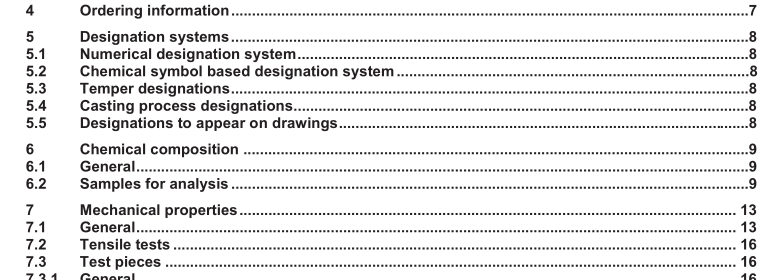EN 1706:2010 – Aluminium and aluminium alloys – Castings – Chemical composition and mechanical properties

1 Scope
This European Standard specifies the chemical composition limits for aluminium casting alloys and mechanical properties of separately cast test pieces for these alloys.
Annex B is included as a guide to the selection of alloys for a specific use or process.
This European Standard is intended to be used in conjunction with EN 576, EN 1559-1, EN 1559-4, EN 1676 and EN ISO 8062-3.
2 Normative references
The following referenced documents are indispensable for the application of this document. For dated references, only the edition cited applies. For undated references, the latest edition of the referenced document (including any amendments) applies.
EN 576, Aluminium and aluminium alloys — Unalloyed aluminium ingots for remelting — Specifications
EN 1559-1, Founding — Technical conditions of delivery — Part 1: General
EN 1559-4, Founding — Technical conditions of delivery — Part 4: Additional requirements for aluminium alloy castings
EN 1780-1, Aluminium and aluminium alloys — Designation of alloyed aluminium ingots for remelting, master alloys and castings — Part 1: Numerical designation system
EN 1780-2, Aluminium and aluminium alloys — Designation of alloyed aluminium ingots for remelting, master alloys and castings — Part 2: Chemical symbol based designation system
EN 1780-3, Aluminium and aluminium alloys — Designation of alloyed aluminium ingots for remelting, master alloys and castings — Part 3: Writing rules for chemical composition
EN 10002-1, Metallic materials — Tensile testing — Part 1: Method of test at ambient temperature
EN 12258-1:1998, Aluminium and aluminium alloys — Terms and definitions — Part 1: General terms
EN ISO 6506-1, Metallic materials — Brinell hardness test — Part 1: Test method (ISO 6506-1:2005)
3 Terms and definitions
For the purposes of this document, the terms and definitions given in EN 12258-1:1998 and the following apply.
3.1
casting
process in which molten metal is poured into a mould and solidified
[EN 12258-1:1998, 4.1.1]
3.2
sand casting
process in which molten metal is poured into a sand mould and solidified (at atmospheric pressure)
[EN 12258-1:1998, 4.1.8]
3.3
permanent mould casting
chill casting
process in which molten metal is poured into a permanent metal mould and solidified (at atmospheric pressure)
[EN 12258-1:1998, 4.1.9]
3.4
low pressure die casting
process in which molten metal is poured into a metal mould and solidified under low pressure (typically 7 kPa
above atmospheric pressure)
[EN 12258-1:1998, 4.1.11]
NOTE This process can also be used with a sand mould, being called “low pressure sand casting”.
3.5
pressure die casting
high pressure die casting
process in which molten metal is poured into a permanent metal mould and solidified under high pressure (typically 7 MPa)
[EN 12258-1:1998, 4.1.10]
3.6
investment casting
two step process comprising:
a) fabrication of a ceramic mould around a wax or thermoplastic pattern which is lost during this process;and
b) pouring of metal into this mould
[EN 12258-1:1998, 4.1.12]
3.7
fluidity
ability of an alloy to make thin wall castings and reproduce fine details
3.8
hot tearing
tendency for a crack to form in a casting due to the development of internal stress during solidification
3.9
pressure tightness
tendency not to leak on pressure testing
3.10
order document
document or set of documents to which supplier and purchaser agreed at the time of ordering
NOTE An order document may be an order of the purchaser confirmed by the supplier or a quotation of the supplier confirmed by the purchaser.
4 Ordering information
The order document shall include a reference to this European Standard. It shall include all the ordering information as required in EN 1559-1 and EN 1559-4.
EN 1706:2010 – Aluminium and aluminium alloys – Castings – Chemical composition and mechanical properties